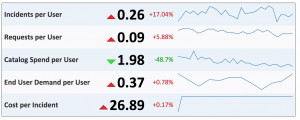One of the most common indicators IT use to understand workload and issues in the environment is by looking at task volumes — for example, new incidents opened by month, or new change requests by location by quarter.
The question you’re trying to answer is “Is the amount of work my organization needs to complete going up or going down?” This can help plan for future staffing or understand issues as they arrive.
However, one weakness of these kind of reports is that it can be difficult to separate the information from background noise. For example, when the number of incidents goes up, is this because of issues in the environment? Or has the organization grown in such a way that you would expect more issues?
With Explore Analytics‘ powerful mash-up and calculation capabilities, you can easily account the size of the user population to shed better understanding on your volumes. The following guide will show an example with ServiceNow on how to generate an Incidents per User report.
